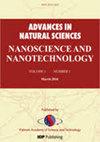Effect of stabilization and carbonization treatment on the chemical and physical transformation of polyacrylonitrile (PAN) based electrospun carbon nanofibers
IF 2.1
Q3 MATERIALS SCIENCE, MULTIDISCIPLINARY
Advances in Natural Sciences: Nanoscience and Nanotechnology
Pub Date : 2024-05-27
DOI:10.1088/2043-6262/ad4bb0
引用次数: 0
Abstract
The present study delves into the production of carbon nanofibers (CNFs) utilising electrospun polyacrylonitrile (PAN) nanofiber mats, with a specific focus on the influence of oxidative stabilisation and carbonisation treatments. This research aims to thoroughly understand how variations in stabilisation time and temperature, as well as carbonisation temperature, impact the CNFs properties. These properties include fiber size, morphology, chemical and crystal structure transformation, thermal behaviour, and surface characteristics. Our methodology involved a detailed examination of the thermal treatment processes, where we observed a significant decrease in fiber size, though the surface morphology of the fibers remained largely unaffected. We employed Fourier-transform infrared (FTIR) spectroscopy to track the transformation of nitrile groups in PAN to imine groups, which indicated the progression of cyclisation reactions. Complementary analyses through differential scanning calorimetry (DSC) confirmed a high degree of these reactions, particularly at stabilisation temperatures extending to 250 °C and beyond. The cyclisation process was found to be complete during the carbonisation phase, at temperatures reaching 450 °C and above. Further, x-ray diffraction (XRD) patterns offered insight into the changes in the crystal structure, particularly in the packing of the d(002) spacing because of the stabilisation and carbonisation processes. This findings from this study not only elucidate the intricate process of CNFs production from electrospun PAN nanofiber mats but also highlight the critical factors that influence their final properties. These insights are invaluable for the development of advanced CNFs with tailored properties suitable for a range of applications, including but not limited to energy storage, electronics, and as supporting materials in various technological domains.稳定化和碳化处理对基于聚丙烯腈(PAN)的电纺碳纳米纤维的化学和物理变化的影响
本研究深入探讨了利用电纺聚丙烯腈(PAN)纳米纤维毡生产碳纳米纤维(CNFs)的过程,重点关注氧化稳定和碳化处理的影响。这项研究旨在深入了解稳定时间和温度以及碳化温度的变化如何影响 CNFs 的特性。这些特性包括纤维尺寸、形态、化学和晶体结构转变、热行为和表面特征。我们的方法包括对热处理过程进行详细检查,我们观察到纤维尺寸显著减小,但纤维的表面形态基本未受影响。我们采用傅立叶变换红外(FTIR)光谱跟踪 PAN 中腈基转变为亚胺基的过程,这表明了环化反应的进展。通过差示扫描量热法(DSC)进行的补充分析证实了这些反应的高度,尤其是在稳定温度达到 250 °C 或更高时。在碳化阶段,当温度达到 450 ℃ 或更高时,循环过程就完成了。此外,X 射线衍射 (XRD) 图样还有助于深入了解晶体结构的变化,特别是稳定化和碳化过程导致的 d(002) 间距的堆积变化。这项研究的发现不仅阐明了从电纺 PAN 纳米纤维毡生产 CNFs 的复杂过程,还强调了影响其最终特性的关键因素。这些见解对于开发具有量身定制特性的先进 CNFs 非常有价值,这些 CNFs 适合于各种应用,包括但不限于能源存储、电子以及各种技术领域的辅助材料。
本文章由计算机程序翻译,如有差异,请以英文原文为准。
求助全文
约1分钟内获得全文
求助全文
来源期刊

Advances in Natural Sciences: Nanoscience and Nanotechnology
NANOSCIENCE & NANOTECHNOLOGYMATERIALS SCIE-MATERIALS SCIENCE, MULTIDISCIPLINARY
自引率
4.80%
发文量
0
 求助内容:
求助内容: 应助结果提醒方式:
应助结果提醒方式:


